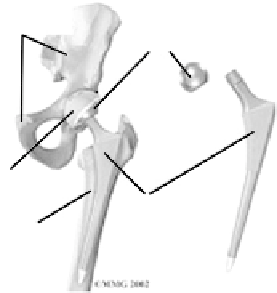Biomedical Engineering Reference
In-Depth Information
a bath of nitric acid to remove any undesirable materials left behind during the
manufacturing process. The other components of the hip implant are also manu-
factured in a series of steps. The femoral head, which is the component that
replaces the top of the natural thigh bone, can be manufactured in approximately
one week. The acetabular cup, which replaces the hip socket of the pelvic bone,
consists of a metallic shell (typically titanium base) with a medical grade ultra-
high molecular weigh polyethylene (UHMWPE) liner. While the metallic shell
takes three to four weeks to manufacture, the liner takes about two weeks. It
should be emphasized that these various processes involve considerable time and
therefore expensive. Additionally, most of the processes are subtractive in nature
and involve signifi cant waste of materials, consequently increasing the cost of
manufacturing.
One of the key manufacturing challenges for hip implants is the strongly con-
trasting property requirements at different locations of the implant. The compo-
nents of a typical hip (femoral) implant used for a total joint replacement (TJR)
are the femoral stem, the femoral head, and the acetabular cup [10] as shown
schematically in Figure 9.1. The property requirements for these individual com-
ponents are listed below [11]:
1. Femoral stem: low elastic modulus (close to bone modulus), high strength,
good ductility, good fatigue resistance, good fracture toughness, good cor-
rosion resistance, no cyto-toxic reactions with the bone tissue, excellent
osseo-integration (attachment to the bone).
2. Femoral head: excellent wear resistance, good fracture toughness, good
corrosion resistance, no cyto-toxic reactions with the bone tissue.
3. Acetabular cup: good corrosion resistance, no cyto - toxic reactions with
the bone tissue, excellent osseo-integration, and, excellent wear resistance
to the counterface material of the femoral head.
Femoral
Ball
Pelvis
Acetabular cup
Femoral
Stem
Femur
Figure 9.1.
Schematic representation of typical hip implant showing the femoral head (or
ball), femoral stem and acetabular cup.

Search WWH ::

Custom Search